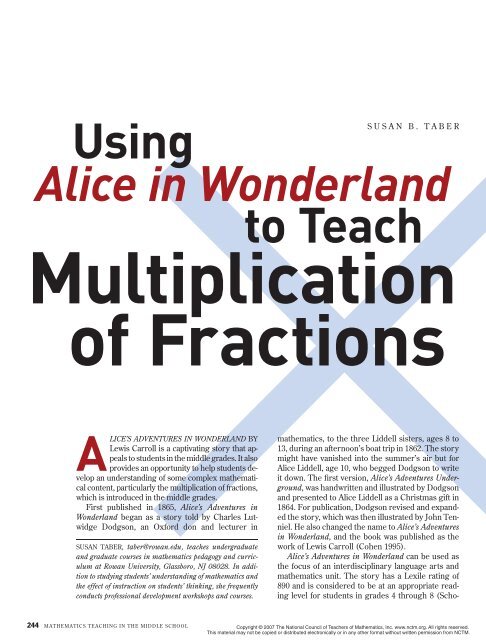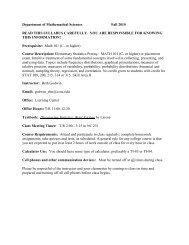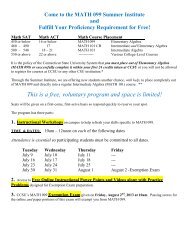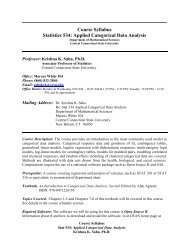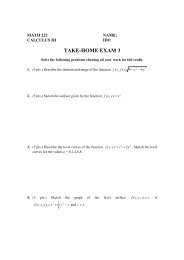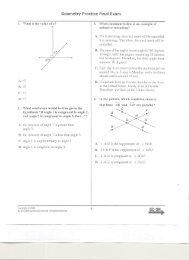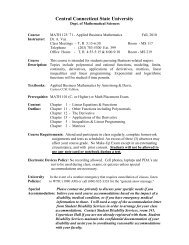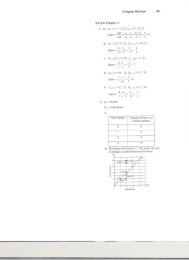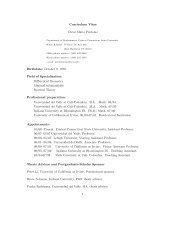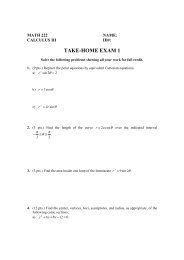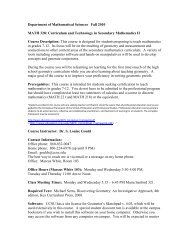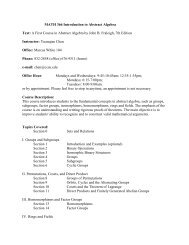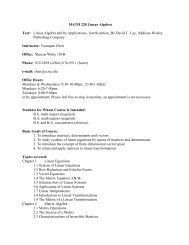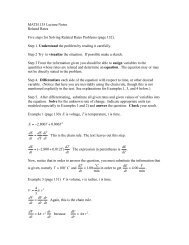Using Alice in Wonderland to Teach Multiplication of Fractions
Using Alice in Wonderland to Teach Multiplication of Fractions
Using Alice in Wonderland to Teach Multiplication of Fractions
You also want an ePaper? Increase the reach of your titles
YUMPU automatically turns print PDFs into web optimized ePapers that Google loves.
<strong>Us<strong>in</strong>g</strong><br />
<strong>Alice</strong> <strong>in</strong> <strong>Wonderland</strong><br />
<strong>to</strong> <strong>Teach</strong><br />
<strong>Multiplication</strong><br />
<strong>of</strong> <strong>Fractions</strong><br />
ALICE’S ADVENTURES IN WONDERLAND BY<br />
Lewis Carroll is a captivat<strong>in</strong>g s<strong>to</strong>ry that appeals<br />
<strong>to</strong> students <strong>in</strong> the middle grades. It also<br />
provides an opportunity <strong>to</strong> help students develop<br />
an understand<strong>in</strong>g <strong>of</strong> some complex mathematical<br />
content, particularly the multiplication <strong>of</strong> fractions,<br />
which is <strong>in</strong>troduced <strong>in</strong> the middle grades.<br />
First published <strong>in</strong> 1865, <strong>Alice</strong>’s Adventures <strong>in</strong><br />
<strong>Wonderland</strong> began as a s<strong>to</strong>ry <strong>to</strong>ld by Charles Lutwidge<br />
Dodgson, an Oxford don and lecturer <strong>in</strong><br />
SuSAN TABER, taber@rowan.edu, teaches undergraduate<br />
and graduate courses <strong>in</strong> mathematics pedagogy and curriculum<br />
at Rowan University, Glassboro, NJ 08028. In addition<br />
<strong>to</strong> study<strong>in</strong>g students’ understand<strong>in</strong>g <strong>of</strong> mathematics and<br />
the effect <strong>of</strong> <strong>in</strong>struction on students’ th<strong>in</strong>k<strong>in</strong>g, she frequently<br />
conducts pr<strong>of</strong>essional development workshops and courses.<br />
244 MATHEMATICS TEACHING IN THE MIDDLE SCHOOL<br />
S u S A N B . T A B E R<br />
mathematics, <strong>to</strong> the three Liddell sisters, ages 8 <strong>to</strong><br />
13, dur<strong>in</strong>g an afternoon’s boat trip <strong>in</strong> 1862. The s<strong>to</strong>ry<br />
might have vanished <strong>in</strong><strong>to</strong> the summer’s air but for<br />
<strong>Alice</strong> Liddell, age 10, who begged Dodgson <strong>to</strong> write<br />
it down. The fi rst version, <strong>Alice</strong>’s Adventures Underground,<br />
was handwritten and illustrated by Dodgson<br />
and presented <strong>to</strong> <strong>Alice</strong> Liddell as a Christmas gift <strong>in</strong><br />
1864. For publication, Dodgson revised and expanded<br />
the s<strong>to</strong>ry, which was then illustrated by John Tenniel.<br />
He also changed the name <strong>to</strong> <strong>Alice</strong>’s Adventures<br />
<strong>in</strong> <strong>Wonderland</strong>, and the book was published as the<br />
work <strong>of</strong> Lewis Carroll (Cohen 1995).<br />
<strong>Alice</strong>’s Adventures <strong>in</strong> <strong>Wonderland</strong> can be used as<br />
the focus <strong>of</strong> an <strong>in</strong>terdiscipl<strong>in</strong>ary language arts and<br />
mathematics unit. The s<strong>to</strong>ry has a Lexile rat<strong>in</strong>g <strong>of</strong><br />
890 and is considered <strong>to</strong> be at an appropriate read<strong>in</strong>g<br />
level for students <strong>in</strong> grades 4 through 8 (Scho-<br />
Copyright © 2007 The National Council <strong>of</strong> <strong>Teach</strong>ers <strong>of</strong> Mathematics, Inc. www.nctm.org. All rights reserved.<br />
This material may not be copied or distributed electronically or <strong>in</strong> any other format without written permission from NCTM.
lastic 2004). (A Lexile rat<strong>in</strong>g is a scale used <strong>to</strong> determ<strong>in</strong>e<br />
the read<strong>in</strong>g level <strong>of</strong> a particular text.—Ed.) The<br />
s<strong>to</strong>ry is familiar <strong>to</strong> most children who have either<br />
read the book or who have seen the movie; that familiarity<br />
can support students’ understand<strong>in</strong>g <strong>of</strong> the<br />
text. The follow<strong>in</strong>g list describes four crucial mathematics<br />
concepts related <strong>to</strong> multiplication <strong>of</strong> fractions<br />
and proportional reason<strong>in</strong>g that can be developed<br />
dur<strong>in</strong>g an <strong>in</strong>terdiscipl<strong>in</strong>ary unit:<br />
1. <strong>Multiplication</strong> by a number less than 1 results <strong>in</strong><br />
a product that is less than the orig<strong>in</strong>al number,<br />
and multiplication by a number greater than 1 results<br />
<strong>in</strong> a product that is more than the orig<strong>in</strong>al<br />
number<br />
2. <strong>Multiplication</strong> by a very small number will result<br />
<strong>in</strong> a very small product but will not result <strong>in</strong> a<br />
product <strong>of</strong> 0<br />
3. The dist<strong>in</strong>ction between additive/subtractive<br />
change and multiplicative change<br />
4. The multiplicative relationships that are at the<br />
heart <strong>of</strong> proportionality and similarity<br />
<strong>Multiplication</strong> by a number less than 1. The multiplication<br />
<strong>of</strong> fractions is a complex mathematics<br />
concept and is <strong>of</strong>ten diffi cult for students and adults.<br />
Studies have shown that even after learn<strong>in</strong>g <strong>to</strong> compute<br />
the products <strong>of</strong> fractions or decimals, most<br />
students have diffi culty solv<strong>in</strong>g multiplication word<br />
problems <strong>in</strong>volv<strong>in</strong>g fractions or decimals less than 1<br />
(Graeber 1993; Greer 1992). For example, after two<br />
weeks <strong>of</strong> <strong>in</strong>struction on multiplication <strong>of</strong> fractions,<br />
the majority <strong>of</strong> students <strong>in</strong> a fi fth-grade class solved<br />
problems like the follow<strong>in</strong>g by divid<strong>in</strong>g the whole<br />
number by the denom<strong>in</strong>a<strong>to</strong>r and multiply<strong>in</strong>g the result<br />
by the numera<strong>to</strong>r.<br />
JoAnne’s dog weighs 21 pounds on earth. On a smaller<br />
planet it would weigh 2/3 as much. How much would it<br />
weigh on the other planet?<br />
On the other hand, the students used multiplication<br />
<strong>to</strong> solve a problem like this one:<br />
Dave’s science report was 1/3 <strong>of</strong> a page long. Frank’s his<strong>to</strong>ry<br />
report was 12 times as long as Dave’s report. How<br />
many pages long was Frank’s report?<br />
Even though the students knew how <strong>to</strong> correctly<br />
fi nd the product <strong>of</strong> two fractions and <strong>of</strong> whole numbers<br />
and fractions, most <strong>of</strong> them did not th<strong>in</strong>k <strong>of</strong> the<br />
fi rst <strong>of</strong> these two problems as be<strong>in</strong>g a multiplication<br />
problem even though it was placed immediately after<br />
the science-report problem on the page.<br />
One reason for this is that the two fac<strong>to</strong>rs <strong>in</strong> multiplicative<br />
situations play different roles. One fac<strong>to</strong>r is<br />
the opera<strong>to</strong>r or multiplier; it affects the change <strong>in</strong> the<br />
other fac<strong>to</strong>r, the quantity. Although people easily recognize<br />
problems that have whole-number multipliers<br />
as be<strong>in</strong>g multiplication situations, diffi culties arise<br />
when the multipliers are fractions or decimals less<br />
than 1. Many students and adults th<strong>in</strong>k that these<br />
situations do not <strong>in</strong>volve multiplication but rather division<br />
or subtraction because the result<strong>in</strong>g quantity<br />
is smaller than the quantity named <strong>in</strong> the problem<br />
(Taber 1999). If students become accus<strong>to</strong>med <strong>to</strong><br />
solv<strong>in</strong>g problems like the fi rst one (JoAnne’s dog)<br />
by divid<strong>in</strong>g and then multiply<strong>in</strong>g, they may come <strong>to</strong><br />
believe that problems that ask them <strong>to</strong> fi nd a fraction<br />
<strong>of</strong> a quantity are solved by division. If the problem<br />
asked them <strong>to</strong> fi nd 2/3 <strong>of</strong> 21 1/2 pounds or <strong>of</strong> 5/8<br />
pound, however, the method <strong>of</strong> divid<strong>in</strong>g by the denom<strong>in</strong>a<strong>to</strong>r<br />
and multiply<strong>in</strong>g by the numera<strong>to</strong>r would<br />
be much more diffi cult <strong>to</strong> carry out.<br />
Instruction on multiplication <strong>of</strong> fractions, therefore,<br />
needs <strong>to</strong> help students extend and transform their<br />
understand<strong>in</strong>g <strong>of</strong> whole-number multiplication <strong>to</strong> <strong>in</strong>clude<br />
new k<strong>in</strong>ds <strong>of</strong> problem situations. For students<br />
<strong>to</strong> understand that multiplication can solve problems<br />
with fraction multipliers requires them <strong>to</strong> extend and<br />
reconceptualize their understand<strong>in</strong>g <strong>of</strong> multiplication<br />
<strong>to</strong> <strong>in</strong>clude multiplication by fraction multipliers.<br />
In teach<strong>in</strong>g a unit on multiplication <strong>of</strong> fractions<br />
<strong>to</strong> another class <strong>of</strong> fi fth-grade students, I used the<br />
s<strong>to</strong>ry <strong>of</strong> <strong>Alice</strong>’s Adventures <strong>in</strong> <strong>Wonderland</strong> <strong>to</strong> help<br />
students understand that multiplication can shr<strong>in</strong>k<br />
quantities as well as enlarge them. The students<br />
and I reviewed the various th<strong>in</strong>gs that happened <strong>to</strong><br />
<strong>Alice</strong> after she ate cake or drank potions from bottles.<br />
“Did you know,” I asked them, “that Lewis Carroll<br />
was really a mathematician named Charles L. Dodgson?<br />
Let’s see how we can show with mathematics<br />
the k<strong>in</strong>ds <strong>of</strong> th<strong>in</strong>gs that happened <strong>to</strong> <strong>Alice</strong> <strong>in</strong> the<br />
s<strong>to</strong>ry. Let’s suppose that <strong>Alice</strong> is 4 1/2 feet tall, that’s<br />
54 <strong>in</strong>ches.” I wrote “54 <strong>in</strong>ches” on the board and<br />
drew a little bottle next <strong>to</strong> it. “Now we’re go<strong>in</strong>g <strong>to</strong><br />
have her dr<strong>in</strong>k from this little bottle that will make<br />
her 1/9 <strong>of</strong> her present size,” I said as I wrote 1/9 on<br />
the bottle. “How tall will she be after she dr<strong>in</strong>ks?”<br />
“Six <strong>in</strong>ches,” the students replied. I wrote “=6” on<br />
the board <strong>to</strong> the right <strong>of</strong> the bottle.<br />
“That’s pretty small,” I said. “Suppose it was a<br />
1/3 bottle she drank from <strong>in</strong>stead?” I wrote “54” and<br />
drew a bottle labeled 1/3 next <strong>to</strong> it. “How tall would<br />
she be then?”<br />
“Eighteen <strong>in</strong>ches,” Jamal said, and the rest <strong>of</strong> the<br />
class nodded <strong>in</strong> agreement. I recorded “=18 <strong>in</strong>ches”<br />
on the board.<br />
“Let’s let her dr<strong>in</strong>k from a . . .” I began, but was <strong>in</strong>terrupted<br />
by Donald, who said, “One-sixth bottle.”<br />
I wrote “54” and a bottle labeled 1/6 on the<br />
board.<br />
VOL. 12, NO. 5 . DECEMBER 2006/ JANuAR Y 2007 245
IllustratIon by John tennIel, from <strong>Alice</strong>’s Adventures <strong>in</strong> WonderlAnd by lewIs Carroll<br />
“That’s 9 <strong>in</strong>ches,” Tamika said. I wrote “= 9 <strong>in</strong>ches”<br />
on the board.<br />
“Now I want <strong>to</strong> see what would happen if she<br />
drank from a 5/6 bottle,” I said, writ<strong>in</strong>g 54 followed<br />
by a bottle labeled 5/6.<br />
“Oh, this is easy,” said several students. “It’s<br />
45 <strong>in</strong>ches.”<br />
I asked Ken <strong>to</strong> expla<strong>in</strong> how he found 45 <strong>in</strong>ches.<br />
“If 1/6 is 9 <strong>in</strong>ches,” he said, “then 5/6 would be 9<br />
times 5 and that’s 45.”<br />
I called the students’ attention <strong>to</strong> the list we had<br />
made on the board (fig. 1). “This shows that we’re<br />
chang<strong>in</strong>g <strong>Alice</strong>’s height when she dr<strong>in</strong>ks from the<br />
bottles. What mathematical symbol should we put <strong>in</strong><br />
here between <strong>Alice</strong>’s height and the bottles?”<br />
<strong>Alice</strong>’s Height<br />
Start Bottle F<strong>in</strong>ish<br />
54 <strong>in</strong>ches 1/9<br />
= 6 <strong>in</strong>ches<br />
54 <strong>in</strong>ches 1/3<br />
= 18 <strong>in</strong>ches<br />
54 <strong>in</strong>ches 1/6<br />
= 9 <strong>in</strong>ches<br />
54 <strong>in</strong>ches 5/6<br />
= 45 <strong>in</strong>ches<br />
Fig. 1 Changes <strong>in</strong> <strong>Alice</strong>’s size<br />
Fig. 2 <strong>Alice</strong> and the Caterpillar<br />
246 MATHEMATICS TEACHING IN THE MIDDLE SCHOOL<br />
“Division,” Jamal said. “You’re divid<strong>in</strong>g 54 by 1/9.”<br />
Stephanie raised her hand. “It’s multiplication.<br />
You’re multiply<strong>in</strong>g 54 by 1/9.”<br />
“How many th<strong>in</strong>k we’re divid<strong>in</strong>g?” I asked. About<br />
a third <strong>of</strong> the students raised their hands. “How many<br />
th<strong>in</strong>k we’re multiply<strong>in</strong>g?” Another third raised their<br />
hands. “How many are not sure? Let’s take a small<br />
<strong>Alice</strong> and make her get bigger. Maybe that will help<br />
us figure out what’s go<strong>in</strong>g on.” We then pretended<br />
that <strong>Alice</strong> ate cakes labeled with various whole numbers<br />
and fractions greater than 1. Students computed<br />
her height after she ate each cake. We then<br />
discussed the appropriate operation symbol <strong>to</strong> put<br />
between the beg<strong>in</strong>n<strong>in</strong>g height and either the cake<br />
or the bottle. Students agreed that the multiplication<br />
symbol would work <strong>in</strong> either situation: when <strong>Alice</strong><br />
was shr<strong>in</strong>k<strong>in</strong>g as well as when she was grow<strong>in</strong>g.<br />
Before beg<strong>in</strong>n<strong>in</strong>g the lesson the next day, one<br />
student’s question <strong>in</strong>dicated <strong>to</strong> me that the students<br />
were beg<strong>in</strong>n<strong>in</strong>g <strong>to</strong> understand that multiplication<br />
could <strong>in</strong>deed decrease a quantity. Carrie<br />
asked, “Why is it when we times 29 times 2/9 that<br />
the answer goes down?”<br />
I wanted <strong>to</strong> be sure that I unders<strong>to</strong>od her question,<br />
so I asked one <strong>of</strong> my own: “Your question is that<br />
if we multiply 29 times 2/9, it’s smaller than what?”<br />
“Twenty-n<strong>in</strong>e,” Carrie replied. I asked if anyone<br />
<strong>in</strong> the class could th<strong>in</strong>k <strong>of</strong> a reason.<br />
N<strong>in</strong>a quickly raised her hand, “If you times 29<br />
times 1, you get 29, but 2/9 isn’t a complete 1, so<br />
you get less than 29.”<br />
Alan contributed, “Twenty-n<strong>in</strong>e 2/9 is like count<strong>in</strong>g<br />
2/9 [a <strong>to</strong>tal <strong>of</strong>] 29 times.”<br />
Carrie’s question and N<strong>in</strong>a’s and Alan’s responses<br />
showed that students were beg<strong>in</strong>n<strong>in</strong>g <strong>to</strong> understand<br />
the relationship between multiply<strong>in</strong>g by numbers<br />
greater than 1 and less than 1. This pr<strong>in</strong>ciple <strong>of</strong> multiplication<br />
is articulated by the Caterpillar <strong>in</strong> the s<strong>to</strong>ry.<br />
Before meet<strong>in</strong>g the Caterpillar, <strong>Alice</strong> is frustrated<br />
by her <strong>in</strong>ability <strong>to</strong> control her changes <strong>in</strong> size. She<br />
has no reliable way <strong>of</strong> predict<strong>in</strong>g whether she will<br />
grow larger or smaller. Dr<strong>in</strong>k<strong>in</strong>g from the first bottle<br />
makes her shr<strong>in</strong>k <strong>to</strong> 10 <strong>in</strong>ches, but dr<strong>in</strong>k<strong>in</strong>g from the<br />
bottle she f<strong>in</strong>ds <strong>in</strong> the White Rabbit’s house makes<br />
her grow <strong>to</strong>o large for the house. Eat<strong>in</strong>g one cake<br />
enlarges her from 10 <strong>in</strong>ches <strong>to</strong> over 9 feet tall, but<br />
eat<strong>in</strong>g the pebble-cakes causes her <strong>to</strong> shr<strong>in</strong>k small<br />
enough so that she can walk through the rabbit’s<br />
door. <strong>Alice</strong> beg<strong>in</strong>s <strong>to</strong> be able <strong>to</strong> control her changes<br />
<strong>in</strong> size after her conversation with the Caterpillar:<br />
“One side will make you grow taller, and the other side<br />
will make you grow shorter.”<br />
“One side <strong>of</strong> what? The other side <strong>of</strong> what?” thought <strong>Alice</strong><br />
<strong>to</strong> herself.<br />
“Of the mushroom,” said the Caterpillar. (Carroll 1992, p. 68)
Although a round mushroom cap does not have<br />
“sides,” <strong>Alice</strong> copes with the situation by break<strong>in</strong>g <strong>of</strong>f<br />
diametrically opposite pieces <strong>of</strong> the mushroom. (See<br />
the illustration <strong>in</strong> fig. 2.) After experiment<strong>in</strong>g <strong>to</strong> f<strong>in</strong>d<br />
out which part <strong>of</strong> the mushroom makes her grow<br />
and which makes her shr<strong>in</strong>k, <strong>Alice</strong> is able <strong>to</strong> change<br />
her size <strong>to</strong> suit her purposes: <strong>to</strong> participate <strong>in</strong> the tea<br />
party and then <strong>to</strong> unlock the door and enter the garden.<br />
<strong>Alice</strong>’s ability <strong>to</strong> control whether she will grow<br />
larger or smaller corresponds <strong>to</strong> students’ understand<strong>in</strong>g<br />
that multiplication by a number larger than<br />
1 <strong>in</strong>creases the quantity be<strong>in</strong>g multiplied, whereas<br />
multiply<strong>in</strong>g by a number less than 1 decreases it.<br />
The worksheet titled “How Tall Is <strong>Alice</strong>?” gave students<br />
a chance <strong>to</strong> practice multiplication <strong>of</strong> fractions<br />
and <strong>to</strong> expla<strong>in</strong> their emerg<strong>in</strong>g understand<strong>in</strong>g <strong>of</strong> the<br />
relationships between the magnitude <strong>of</strong> the multiplier<br />
and its effect on the start<strong>in</strong>g quantity. The s<strong>to</strong>ries<br />
that Carmella wrote for the three problems at the end<br />
<strong>of</strong> the worksheet (fig. 3) show that she is develop<strong>in</strong>g<br />
an understand<strong>in</strong>g that multiplication can shr<strong>in</strong>k<br />
(“m<strong>in</strong>imize”) as well as enlarge (“grow”) quantities.<br />
Although it is conventional <strong>to</strong> th<strong>in</strong>k <strong>of</strong> the first quantity<br />
<strong>in</strong> the multiplication expression as the multiplier,<br />
it is clear from Carmella’s word problems that she<br />
is not follow<strong>in</strong>g that convention. In the first, she describes<br />
f<strong>in</strong>d<strong>in</strong>g 3/4 <strong>of</strong> 27, and <strong>in</strong> the second problem,<br />
she f<strong>in</strong>ds 2/3 <strong>of</strong> 15. Her third problem describes f<strong>in</strong>d<strong>in</strong>g<br />
20 times as much as 5/6. Nevertheless, her s<strong>to</strong>ry<br />
problems <strong>in</strong>dicate an understand<strong>in</strong>g that multiplication<br />
can result <strong>in</strong> “shr<strong>in</strong>k<strong>in</strong>g” or “grow<strong>in</strong>g.”<br />
To compare changes <strong>in</strong> these students’ th<strong>in</strong>k<strong>in</strong>g<br />
with those <strong>of</strong> the students <strong>in</strong> the first class about<br />
multiplication problems <strong>in</strong>volv<strong>in</strong>g fractions, I gave<br />
the students a pretest and a posttest <strong>of</strong> twenty word<br />
problems, ten with fraction multipliers and ten with<br />
whole-number multipliers. I compared the solution<br />
strategies they used with those employed by the first<br />
TABLE 1<br />
Fig. 3 Carmella’s word problems<br />
class <strong>of</strong> fifth graders on the same pre- and posttests.<br />
Table 1 shows that the students who had discussed<br />
<strong>Alice</strong>’s Adventures <strong>in</strong> <strong>Wonderland</strong> and had learned <strong>to</strong><br />
represent changes <strong>in</strong> her size with multiplication used<br />
multiplication much more frequently on all the posttest<br />
problems, whether the multipliers were whole<br />
numbers or fractions. Of the “<strong>Alice</strong>” students, 75<br />
percent used multiplication <strong>to</strong> solve all the problems<br />
and only 19 percent used division <strong>to</strong> solve problems<br />
with fraction multipliers compared with 28 percent<br />
<strong>of</strong> the “non-<strong>Alice</strong>” students who used multiplication<br />
<strong>to</strong> solve all problems and 64 percent who divided <strong>to</strong><br />
solve the posttest problems that had fraction multipliers.<br />
Many more “<strong>Alice</strong>” students had successfully<br />
extended their ideas about multiplication <strong>to</strong> <strong>in</strong>clude<br />
multiplication by fractional multipliers.<br />
Interviews with five “<strong>Alice</strong>” students confirmed<br />
these changes <strong>in</strong> their understand<strong>in</strong>g <strong>of</strong> multiplication.<br />
Before the <strong>in</strong>struction, they said that the only<br />
problems that could be solved by multiplication or<br />
repeated addition were those with whole-number<br />
Percent <strong>of</strong> Students Employ<strong>in</strong>g Each Strategy Pattern <strong>to</strong> Solve Word Problems with Whole-<br />
Number and Fraction Multipliers<br />
Non-<strong>Alice</strong> Students<br />
(n = 25)<br />
<strong>Alice</strong> Students<br />
(n = 21)<br />
Strategy Pattern Pretest Posttest Pretest Posttest<br />
Multiplied <strong>to</strong> solve all problems 4 28 0 77<br />
Multiplied <strong>to</strong> solve problems<br />
with whole-number multipliers<br />
and divided <strong>to</strong> solve problems<br />
with fraction multipliers<br />
32 60 62 19<br />
Divided <strong>to</strong> solve all problems 12 4 5 0<br />
used a diagram 8 0 10 0<br />
No strategy pattern 44 8 24 5<br />
VOL. 12, NO. 5 . DECEMBER 2006/ JANuAR Y 2007 247
IllustratIon by John tennIel, from <strong>Alice</strong>’s Adventures <strong>in</strong> WonderlAnd<br />
by lewIs Carroll<br />
Fig. 4 The Cheshire Cat<br />
multipliers. Students who were able <strong>to</strong> solve the<br />
problems with fraction multipliers used division<br />
strategies. See the follow<strong>in</strong>g problem:<br />
A car<strong>to</strong>n will hold 42 notebooks. If the car<strong>to</strong>n is 5/6 full,<br />
how many notebooks are <strong>in</strong> the car<strong>to</strong>n?<br />
After <strong>in</strong>struction, Tamika, like the other <strong>in</strong>terviewed<br />
students, said that she would solve the problem by<br />
multiply<strong>in</strong>g 42 by 5/6. “Because you’re go<strong>in</strong>g <strong>to</strong> f<strong>in</strong>d<br />
it when it’s <strong>in</strong> sixths and then you’ll f<strong>in</strong>d the 5. When<br />
you times it and you’re go<strong>in</strong>g <strong>to</strong> put it <strong>in</strong><strong>to</strong> sixths, it’s<br />
just like divid<strong>in</strong>g it <strong>in</strong><strong>to</strong> sixths and then you get the 5<br />
sixths,” she said. She wrote,<br />
42 5 210<br />
× = = 35.<br />
6 6<br />
Her explanation <strong>in</strong>dicates that she unders<strong>to</strong>od that<br />
5/6 <strong>of</strong> a quantity could be found by multiply<strong>in</strong>g by<br />
5/6 and that she unders<strong>to</strong>od the composite nature<br />
<strong>of</strong> the multiplier 5/6; it simultaneously partitions the<br />
quantity <strong>in</strong><strong>to</strong> sixths and collects 5 <strong>of</strong> them.<br />
<strong>Alice</strong>’s changes <strong>in</strong> size thus provide students with<br />
the opportunity <strong>to</strong> develop an understand<strong>in</strong>g <strong>of</strong> how<br />
multiplication by fractions can symbolize multiplicative<br />
situations <strong>in</strong> which the product is smaller than<br />
the orig<strong>in</strong>al quantity. It can also extend their knowledge<br />
<strong>of</strong> whole-number multiplication <strong>to</strong> <strong>in</strong>clude multiplication<br />
by numbers less than 1. Other <strong>in</strong>cidents<br />
<strong>in</strong> the s<strong>to</strong>ry can afford opportunities <strong>to</strong> develop additional<br />
elegant, yet fundamental, concepts related<br />
<strong>to</strong> multiplication and proportionality.<br />
<strong>Multiplication</strong> by a very small number. The idea<br />
<strong>of</strong> a limit or how small a product can be can also<br />
be discussed. In chapter 2, <strong>Alice</strong> discovers that fann<strong>in</strong>g<br />
herself is caus<strong>in</strong>g her <strong>to</strong> shr<strong>in</strong>k rapidly, and<br />
she drops the fan “just <strong>in</strong> time <strong>to</strong> save herself from<br />
248 MATHEMATICS TEACHING IN THE MIDDLE SCHOOL<br />
shr<strong>in</strong>k<strong>in</strong>g away al<strong>to</strong>gether” (Carroll 1992, p. 22).<br />
<strong>Alice</strong> fears that if she gets <strong>to</strong> be <strong>to</strong>o small, she will<br />
cease <strong>to</strong> exist. Ask students <strong>to</strong> f<strong>in</strong>d <strong>Alice</strong>’s height<br />
if it were multiplied by a very small fraction. Students<br />
might suggest multiply<strong>in</strong>g by 1 one-millionth<br />
or 1 one-billionth. This discussion gives the class a<br />
chance <strong>to</strong> explore <strong>in</strong>formally ideas such as whether<br />
there is a smallest fraction and whether <strong>Alice</strong> would<br />
ever go out <strong>of</strong> existence and completely vanish. Although<br />
<strong>Alice</strong> might become <strong>to</strong>o small <strong>to</strong> see with the<br />
unaided eye, she would not vanish unless her height<br />
were multiplied by 0.<br />
The dist<strong>in</strong>ction between additive/subtractive change<br />
and multiplicative change. Ask<strong>in</strong>g students <strong>to</strong> compare<br />
and contrast the way <strong>in</strong> which the Cheshire Cat<br />
appears and disappears with the changes <strong>in</strong> <strong>Alice</strong>’s<br />
size provides an opportunity <strong>to</strong> discuss the dist<strong>in</strong>ctions<br />
between additive and multiplicative change.<br />
Whether <strong>Alice</strong> shr<strong>in</strong>ks or grows taller, she is always<br />
a complete girl with head, hands, feet, and so on. The<br />
Cheshire Cat, however, appears and disappears part<br />
by part (see fig. 4). In chapter 6, the cat disappears<br />
bit by bit until only the gr<strong>in</strong> rema<strong>in</strong>s. In chapter 8,<br />
the gr<strong>in</strong> appears first, but <strong>Alice</strong> decides not <strong>to</strong> speak<br />
<strong>to</strong> the cat until its ears are seen. The Cheshire Cat<br />
can also disappear completely. His transformations<br />
from visibility <strong>to</strong> <strong>in</strong>visibility result from the additive<br />
operation <strong>of</strong> subtraction, <strong>in</strong> contrast <strong>to</strong> <strong>Alice</strong>’s transformations,<br />
which are multiplicative. It is <strong>in</strong>terest<strong>in</strong>g<br />
<strong>to</strong> note that some characters <strong>in</strong> the s<strong>to</strong>ry, such as<br />
the baby who becomes a pig and the play<strong>in</strong>g cards,<br />
are transformed <strong>in</strong> ways that cannot be represented<br />
mathematically.<br />
Multiplicative relationships at the heart <strong>of</strong> proportionality<br />
and similarity. Multiplicative change also<br />
underlies the concepts <strong>of</strong> proportionality and similarity<br />
<strong>in</strong> the context <strong>of</strong> geometric figures. Sometimes<br />
<strong>Alice</strong>’s changes <strong>in</strong> size preserve her proportions, but<br />
other changes are disproportionate, as when she<br />
says she is “open<strong>in</strong>g out like the largest telescope<br />
that ever was” (Carroll 1992, p. 15); the illustration<br />
<strong>in</strong> chapter 2 shows her as disproportionately taller<br />
(fig. 5). Students could further explore proportionality,<br />
similarity, and the dist<strong>in</strong>ction between additive<br />
and multiplicative change by compar<strong>in</strong>g pairs <strong>of</strong><br />
rectangles like those <strong>in</strong> figure 6, stat<strong>in</strong>g whether<br />
the relationship between the rectangles <strong>in</strong> each pair<br />
is additive or multiplicative and whether the rectangles<br />
are similar. The two rectangles <strong>in</strong> figure 6a<br />
are similar because for both pairs, the sides <strong>of</strong> one<br />
rectangle are 5/3 (or 3/5) the length <strong>of</strong> the sides <strong>of</strong><br />
the other rectangle. The rectangles <strong>in</strong> figure 6b are<br />
not similar. The sides <strong>of</strong> the smaller rectangle are<br />
2 units less than the sides <strong>of</strong> the larger rectangle.
IllustratIon by John tennIel, from <strong>Alice</strong>’s Adventures <strong>in</strong> WonderlAnd by lewIs Carroll<br />
Fig. 5 <strong>Alice</strong> grows out <strong>of</strong> proportion.<br />
The rectangles <strong>in</strong> figure 6c are not similar because<br />
the length has been <strong>in</strong>creased by a fac<strong>to</strong>r <strong>of</strong><br />
2, whereas the width has been <strong>in</strong>creased by a fac<strong>to</strong>r<br />
<strong>of</strong> 3, or the sides <strong>of</strong> the larger rectangle are 6 units<br />
longer than the sides <strong>of</strong> the smaller rectangle. Extend<strong>in</strong>g<br />
the discussion <strong>of</strong> additive and multiplicative<br />
relationships <strong>to</strong> geometric figures will help students<br />
further develop the concepts <strong>of</strong> proportionality that<br />
are common <strong>to</strong> numeric and geometric contexts.<br />
<strong>Alice</strong>’s Adventures <strong>in</strong> <strong>Wonderland</strong> can provide<br />
a rich environment for mathematics and language<br />
learn<strong>in</strong>g. Read<strong>in</strong>g the s<strong>to</strong>ry while learn<strong>in</strong>g about<br />
<strong>to</strong>pics such as multiplication <strong>of</strong> fractions, multiplicative<br />
change, proportional reason<strong>in</strong>g, or similarity<br />
provides a context <strong>of</strong> imag<strong>in</strong>ative representation <strong>in</strong><br />
which students can explore, discuss, and deepen<br />
their understand<strong>in</strong>g <strong>of</strong> mathematics. Focus<strong>in</strong>g on<br />
the mathematical aspects <strong>of</strong> the s<strong>to</strong>ry will also help<br />
students analyze and ga<strong>in</strong> a deeper appreciation for<br />
the literary qualities <strong>of</strong> the s<strong>to</strong>ry.<br />
References<br />
Carroll, Lewis. <strong>Alice</strong>’s Adventures <strong>in</strong> <strong>Wonderland</strong>. Illus. by<br />
John Tenniel. New York: Bantam Doubleday Dell, 1992.<br />
Cohen, Mor<strong>to</strong>n N. Lewis Carroll: A Biography. New York:<br />
Alfred A. Knopf, 1995.<br />
3<br />
3<br />
3<br />
6<br />
6<br />
6<br />
Fig. 6 Similar and nonsimilar rectangles<br />
Graeber, Anna O. “Misconceptions about <strong>Multiplication</strong><br />
and Division.” Arithmetic <strong>Teach</strong>er 40 (March 1993):<br />
408–11.<br />
Greer, Brian. “<strong>Multiplication</strong> and Division as Models <strong>of</strong><br />
Situations.” In Handbook <strong>of</strong> Research on Mathematics<br />
<strong>Teach</strong><strong>in</strong>g and Learn<strong>in</strong>g: A Project <strong>of</strong> the National<br />
Council <strong>of</strong> <strong>Teach</strong>ers <strong>of</strong> Mathematics, edited by Douglas<br />
Grouws, pp. 276–95. New York: Macmillan Publish<strong>in</strong>g<br />
Co., 1992.<br />
Scholastic. “Read<strong>in</strong>g Counts! e-Catalogue.” src.scholastic.<br />
com/ecatalogue/detail_title.asp? Retrieved Oc<strong>to</strong>ber 6,<br />
2004.<br />
Taber, Susan B. “understand<strong>in</strong>g <strong>Multiplication</strong> with <strong>Fractions</strong>:<br />
An Analysis <strong>of</strong> Problem Features and Student<br />
Strategies.” Focus on Learn<strong>in</strong>g Problems <strong>in</strong> Mathematics<br />
21 (Spr<strong>in</strong>g 1999): 1–27.<br />
For more articles relat<strong>in</strong>g mathematics and literature, see the<br />
April 2005 focus issue <strong>of</strong> MTMS, titled “Connect<strong>in</strong>g Mathematics<br />
and Literature <strong>in</strong> the Middle Grades.”—Ed.<br />
9<br />
5<br />
(a)<br />
5<br />
(b)<br />
(c)<br />
10<br />
(See the worksheet on the next page.) l<br />
VOL. 12, NO. 5 . DECEMBER 2006/ JANuAR Y 2007 249<br />
8<br />
12
How Tall Is <strong>Alice</strong>? NAME _______________________________<br />
Show what happens <strong>to</strong> <strong>Alice</strong>’s height when she eats cake or dr<strong>in</strong>ks potions.<br />
A Cake That Makes Her 6 Times as Tall A Potion That Makes Her 1/6 as Tall<br />
Start<strong>in</strong>g Height Equation Start<strong>in</strong>g Height Equation<br />
4 feet 4 feet<br />
8 feet 8 feet<br />
2 feet 2 feet<br />
3/4 foot 3/4 foot<br />
3/8 foot 3/8 foot<br />
A Potion That Makes Her 5/3 Times as Tall A Cake That Makes Her 3/5 as Tall<br />
Start<strong>in</strong>g Height Equation Start<strong>in</strong>g Height Equation<br />
10 feet 10 feet<br />
12 feet 12 feet<br />
8 feet 8 feet<br />
2 feet 2 feet<br />
6 feet 6 feet<br />
If <strong>Alice</strong> dr<strong>in</strong>ks a potion that multiplies her height by 7/8, will she become taller or shorter? Why?<br />
Make up s<strong>to</strong>ries for these problems:<br />
1. 3/4 × 27 =<br />
2. 15 × 2/3 =<br />
3. 5/6 × 20 =<br />
From the December 2006/January 2007 issue <strong>of</strong>


